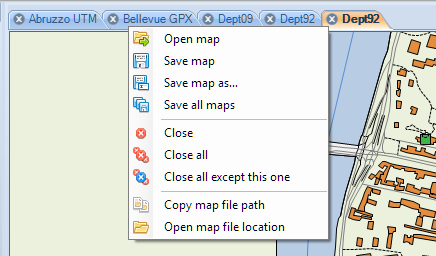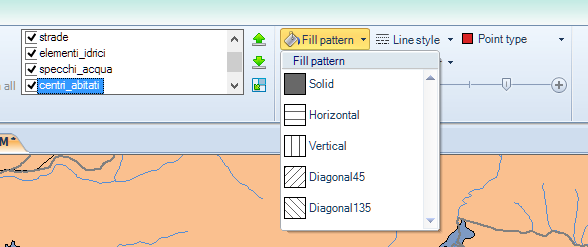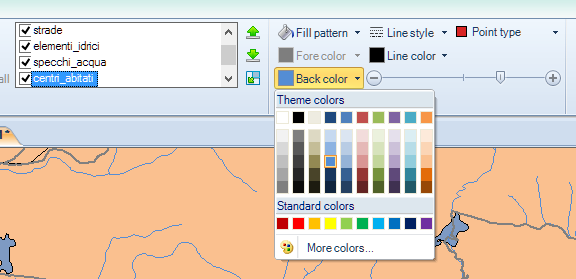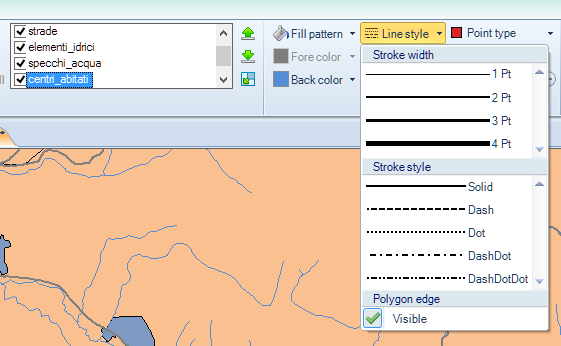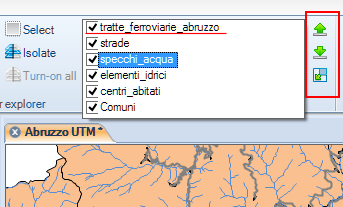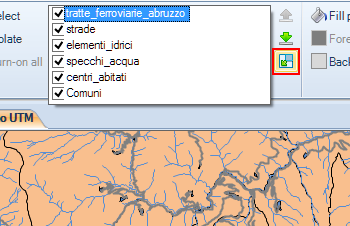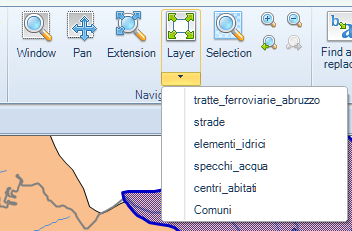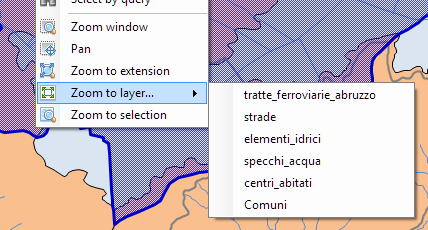Spatial Manager Desktop™ - FAQs: Maps, layers, views
Introduction
- Objective of this section
- To use maps and workspaces. To manage the layers that include the maps. To modify the visual appearance of layers and maps. To navigate through the maps using certain tools to change the display views
- Topics in this section
- Maps and workspaces: opening and saving maps, workspace organization and management of maps and map background
- Layers. Management and styles: loading of layers in a map, arrangement of layers, layer visualization, defining the selected layer, renaming and deleting layers, modifying styles (borders, fills and patterns, lines, point styles and transparency) and user symbols
- Layers split: thematics and data discrimination
- Views and navigation: navigation tools, views and using mouse controls
- Maps and layers properties
How can I handle multiple Maps in Spatial Manager Desktop™?
You can keep open as many Maps as you want in Spatial Manager Desktop™ (only limited by the amount of your system memory), each one located inside its own Workspace. Using the Tabs in the Workspaces, you can:
- Sort the Workspaces: by dragging and dropping the Tab of a Map to the desired location
- Use the Workspaces contextual menu (mouse right-click on the Tab) to:
- Open another Map (Open map). It will be open in a new Workspace
- Save the Map under your right-clicked Tab (Save map)
- Save the Map under your right-clicked Tab using a different name and/or at another location (Save map as)
- Save all open Maps (Save all maps)
- Close the Map under your right-clicked Tab (Close). You will get a warning if this Map has changed
- Close all open Maps (Close all). You will get a warning for every modified Map to close
- Close all open Maps except that is under your right-clicked Tab (Close all except this one). You will get a warning for every modified Map to close
- Copy the file path of the Map under your right-clicked Tab to the Windows clipboard (Copy map file path). This function will be disabled if the Map is a new Map and has not been saved yet
- Open the folder containing the file of the Map under your right-click Tab (Open map file location). This function will be disabled if the Map is a new Map and has not been saved yet
How can I stylize a Map in Spatial Manager Desktop™?
You can stylize the Layers in a Map and the Map background in Spatial Manager Desktop™. These parameters will be saved when you save the Map
- To stylize a Layer in the Map, go to the "Layers" ribbon, select a Layer and apply styles as follows:
- Set up the fill style parameters for polygonal type Features (if any, in the Layer)
- Select the fill pattern
- Select the foreground color (except if you have chosen the "Solid" pattern)
- Select the background color
- Select the opacity/transparency for the background
- Select the line style for the edge (stroke width and stroke style), and select whether or not you want to draw the edge
- Set up the line style parameters for linear type Features (if any, in the Layer)
- Select the line style (stroke width and stroke style)
- Set up the point style for point type Features (if any, in the Layer)
- Select the point type from the predefined point types list or by selecting an image from disk and by defining its insertion base (this image will remain in the point type list, along with the current instance of the application, to select it whenever you want)
- Set up the fill style parameters for polygonal type Features (if any, in the Layer)
- To change the Map background, go to the "Start" ribbon. You can choose:
- A solid color
- A base map from some base map providers like Bing and others (requires an Internet connection)
- Restore the default solid color set in the application configuration
Can I set up any default style value for new Maps or new Layers in Spatial Manager Desktop™?
Yes, in the "Options\Workspaces" window of Spatial Manager Desktop™ you can set up some default style values for new Maps or new Layers:
- Default Map background solid color
- Layer style defaults:
- Default line color
- Default fill background color. For this parameter, you can choose a "Fixed color" or the "Random color" option, which lets the application apply random background colors for polygons in new Layers
- Default point style, that you can choose from the predefined point types list
Furthermore, you can choose the "Antialiasing" option, to display the Maps on the screen using a "smoothing" mode
How can I sort the relative position of the Layers in a Map in Spatial Manager Desktop™?
You can sort the position of the Layers in a Map in Spatial Manager Desktop™ simply by selecting the Layer to move and dragging and dropping it on the Layer list of the ribbon "Layers". Also you can select the Layer to move and use the up and down arrows at the right of the Layer list. The content of the upper Layers will be drawn above the content of the lower Layers in the Maps
Can I expand the list of Layers in a Map in Spatial Manager Desktop™?
Yes, if you need to expand the list of Layers in a Map in Spatial Manager Desktop™, press the "Drop down layer list" button, near to the Layer list. You can also select or sort Layers in the expanded list
How can I change the view of a Map in a Workspace in Spatial Manager Desktop™?
You can change the view of a Map in Spatial Manager Desktop™ choosing different ways to make zooms and pans inside the Workspace:
- Zoom in or zoom out
- Turn the mouse wheel over the place that you want in the Map. One direction of rotation will do zoom in and the opposite will do zoom out
- Click over the "Zoom in" or over the "Zoom out" functions in the ribbon ("Start\Navigation") and select the place in the Map to do it
- Zoom in by rectangular window
- Click over this function in the ribbon ("Start\Navigation") and define the window to zoom in
- Click over this function in the contextual menu (right-click) of the Workspace and define the window to zoom in
- Zoom to the Map extension
- Click over this function in the ribbon ("Start\Navigation")
- Click over this function in the contextual menu (right-click) of the Workspace
- Click twice on the mouse wheel when the cursor is over the Map
- Zoom to a Layer
- Click over this function in the ribbon ("Start\Navigation") and select the Layer that you want to zoom
- Click over this function in the contextual menu (right-click) of the Workspace and select the Layer that you want to zoom
- Click over this function in the ribbon ("Layers\Layer explorer") to zoom to the selected Layer
- Zoom to the Features selection(if any):
- Click over this function in the ribbon ("Selection-Tools\Action") to zoom to the current Features selection
- Click over this function in the contextual menu (right-click) of the Workspace to zoom to the current Features selection
- Pan
- Click over this function in the ribbon ("Start\Navigation") and drag the cursor through the Workspace
- Click over this function in the contextual menu (right-click) of the Workspace and drag the cursor through the Workspace
- Press the mouse wheel and drag the cursor through the Workspace
- Go to the "Previous view" (if any) or the "Next view" (if any): click over these functions in the ribbon ("Start\Navigation")
Some other functions, such as selecting Features in the Data grid or by queries, can make changes in the view of the Map depending on the application configuration
